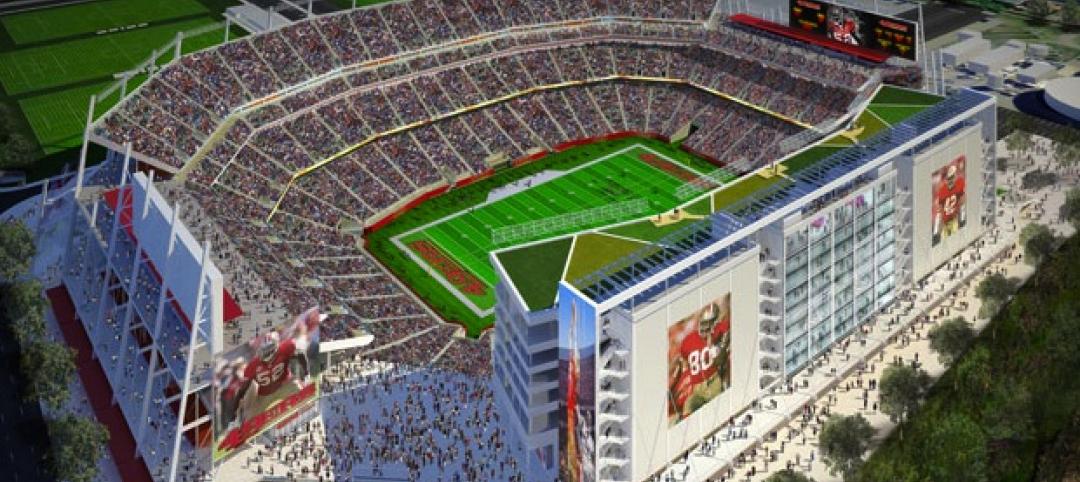For years the Oakland Athletics have been right at the top of the list of teams that desperately need a new ballpark. The Oakland Coliseum has caused the A’s a host of major league problems, chief among them recurring plumbing issues that have led to the clubhouses and dugouts flooding with sewage on numerous occasions.
Today, the team took another step closer to abandoning the problem child that is the Oakland Coliseum and announced it has hired four architecture firms to lead the design process of a new, problem-free home ballpark. Sasaki, Snøhetta, and Studio T-Square will lead the master planning and urban design efforts for the new stadium while HOK and Snøhetta will collaborate on the design.
Additionally, Sasaki, Snøhetta, and Studio T-Square will assist the A’s in a community engagement process. “A key component to making this project a success will be an active and meaningful engagement with A’s fans as well as with the broad and incredibly diverse community of Oakland,” says James Miner, AICP, Sasaki Principal, in a release. “We want the ballpark to be a great place not only for baseball, but also for the community and the environment.” There are no renderings yet, but Miner sees the new stadium as just one piece of the puzzle that will become an “urban ballpark district.”
Brad Schrock, AIA, regional leader of Sports + Recreation +Entertainment at HOK says, “We’re looking forward to collaborating with the A’s and our design partners to create an imaginative, amenity-rich, and enduring community asset.”
Currently, the stadium is being planned for a piece of land that sits next to Lake Merritt near Downtown Oakland. The area is surrounded by parkland and neighborhoods, a stark contrast to the sea of asphalt the Oakland Coliseum exists in. Estimates project the new stadium to seat 35,000 fans and cost approximately $500 million.
Update (12/06/17)
The A's just can't catch a break when it comes to getting a new ballpark. The board of trustees of Peralta Community College District, which owns the site near Laney College the new stadium was being designed for, voted to halt ongoing discussions with the A's.
"We are shocked by Peralta’s decision to not move forward," the A's said in a statement. "All we wanted to do was enter into a conversation about how to make this work for all of Oakland, Laney, & the Peralta Community College District. We are disappointed that we will not have that opportunity."
The next step for the team, if they are unable to rekindle discussions with the Peralta Community College District, is to reexamine other possibilities for a new stadium. The board's decision came as a surprise to the team, however, so a backup plan may not even exist.
Libby Schaaf, Oakland's mayor, remains optimistic about the A's future in the city and the team's ability to build a new ballpark. "Oakland remains fiercely determined to keep the Athletics in Oakland," Schaaf wrote in a statement on Twitter. "It is unfortunate the discussion with Peralta ended so abruptly, yet we're committed, more than ever, to working with the A’s and our community to find the right spot in Oakland for a privately-financed ballpark."
This latest setback comes less than one month after a design team of Sasaki, Snøhetta, Studio T-Square, and HOK were selected to design the new stadium.
Related Stories
| Jun 20, 2014
Sterling Bay pulled on board for Chicago Old Main Post Office project
Sterling Bay Cos. and Bill Davies' International Property Developers North America partner up for a $500 million restoration of Chicago's Old Main Post Office
| Jun 18, 2014
Six World Cup stadiums have achieved LEED certification
In conjunction with the 2014 FIFA World Cup in Brazil, the U.S. Green Building Council (USGBC) announced that six World Cup stadiums have achieved LEED certification, including South America’s largest stadium, Maracanã in Rio de Janeiro.
| Jun 18, 2014
Arup uses 3D printing to fabricate one-of-a-kind structural steel components
The firm's research shows that 3D printing has the potential to reduce costs, cut waste, and slash the carbon footprint of the construction sector.
| Jun 16, 2014
6 U.S. cities at the forefront of innovation districts
A new Brookings Institution study records the emergence of “competitive places that are also cool spaces.”
| Jun 12, 2014
Austrian university develops 'inflatable' concrete dome method
Constructing a concrete dome is a costly process, but this may change soon. A team from the Vienna University of Technology has developed a method that allows concrete domes to form with the use of air and steel cables instead of expensive, timber supporting structures.
| Jun 11, 2014
Esri’s interactive guide to 2014 World Cup Stadiums
California-based Esri, a supplier of GIS software, created a nifty interactive map that gives viewers a satellite perspective of Brazil’s many new stadiums.
| Jun 4, 2014
Construction team named for Atlanta Braves ballpark
A joint venture between Barton Malow, Brasfield & Gorrie, Mortenson Construction, and New South Construction will build the Atlanta Braves ballpark, which is scheduled to open in early 2017. Check out the latest renderings of the plan.
| Jun 2, 2014
Parking structures group launches LEED-type program for parking garages
The Green Parking Council, an affiliate of the International Parking Institute, has launched the Green Garage Certification program, the parking industry equivalent of LEED certification.
| May 29, 2014
7 cost-effective ways to make U.S. infrastructure more resilient
Moving critical elements to higher ground and designing for longer lifespans are just some of the ways cities and governments can make infrastructure more resilient to natural disasters and climate change, writes Richard Cavallaro, President of Skanska USA Civil.
| May 22, 2014
Just two years after opening, $60 million high school stadium will close for repairs
The 18,000-seat Eagle Stadium in Allen, Texas, opened in 2012 to much fanfare. But cracks recently began to appear throughout the structure, causing to the school district to close the facility.















